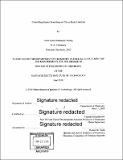Controlling kinetic branching in C0₂-to-fuels catalysis
Author(s)
Wuttig, Anna Lydia Nakamura
DownloadFull printable version (26.50Mb)
Other Contributors
Massachusetts Institute of Technology. Department of Chemistry.
Advisor
Yogesh Surendranath.
Terms of use
Metadata
Show full item recordAbstract
While electrified transition-metal surfaces mediate the synthesis of carbonaceous products from CO₂, these processes suffer efficiency losses due to the multitude of products accessible over a narrow potential range. Selective product formation requires knowledge and control over various branch points in the reaction pathway. In this work, we will present two specific branch points: (1) the requirements for selective activation of CO₂ over H+ to form the two-electron reduced CO product; and (2) the requirements for the accumulation of surface-bound CO species that can be reduced to higher order products beyond CO. Using model Au and Cu electrocatalysts, we uncover mechanistic insights into these branch points. We identify the differential proton-coupling requirements for CO₂ versus H+ activation on polycrystalline Au surfaces that establish a mechanistic basis for CO versus H₂ product selectivity. Electrokinetic data are consistent with a mechanism of CO production involving rate-limiting single electron transfer to CO₂ with concomitant adsorption to surface-active sites, followed by one electron, two proton transfer, and CO liberation from the surface. In contrast, the data suggest a H₂ evolution mechanism involving rate-limiting single electron transfer coupled with proton transfer from bicarbonate, hydronium, and/or carbonic acid to form adsorbed H species, followed by sequential one electron, one proton transfer or H recombination reactions. We elucidate the differential CO electrosorption dynamics on polycrystalline Au and Cu surfaces using temperature-dependent in-situ surface-enhanced infrared absorption spectroscopy, establishing a mechanistic basis for potential-dependent CO binding. On Au surfaces, we observe that reversible linearly-bonded CO electrosorption is a water substitution process, where bound CO species readily dissociate from the surface upon negative potential bias. Conversely, labile CO species accumulate upon negative potential bias on Cu surfaces via a charge displacement reaction with carbonate, providing a pool of reactant primed for further reduction to higher order products. The enthalpy and entropy of electrosorption are also quantified.
Description
Thesis: Ph. D., Massachusetts Institute of Technology, Department of Chemistry, 2018. Cataloged from PDF version of thesis. Includes bibliographical references.
Date issued
2018Department
Massachusetts Institute of Technology. Department of ChemistryPublisher
Massachusetts Institute of Technology
Keywords
Chemistry.